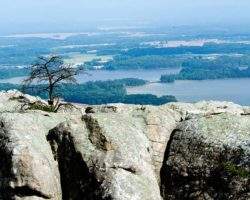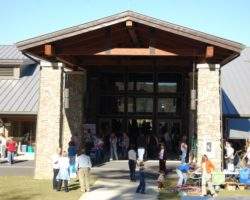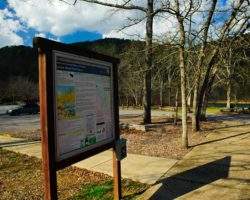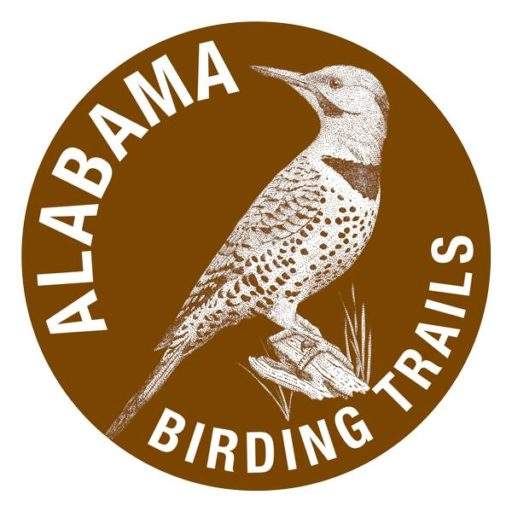Appalachian Highlands | Cherokee | Best Seasons: Fall | Spring | Winter
Weiss Lake, a 30,200 acre impoundment owned and operated by the Alabama Power Company, is fed by the Coosa, Chattooga and Little Rivers, and offers over 447 miles of shoreline and shallow flats, large coves, under-water drop offs and deep channels. The preferred starting point for birding Weiss Lake is the boat launch area on the west side of AL 68 in the middle of the Chattooga Bridge, which spans the main body of the lake. From this point, scan the waters for gulls – primarily Ring-billed, Bonaparte’s, Herring, and the occasional rarity, such as Glaucous or Lesser Black-backed, and even a few Franklin’s in November. In winter, a handful of Forster’s Terns, hordes of Double-crested Cormorants, American White Pelicans, and other wintering waterfowl may be visible. Common Loons, Horned Grebes, and a variety of dabbling and diving ducks occur here. The loons and Horned Grebes, as well as the “bay” ducks such as Buffleheads, Canvasbacks, Ruddy Ducks, Common Goldeneyes, Redheads, and the like are generally in the deeper, open water to the west, and across the highway on the east.
There is another public access point on the east side. The “marsh” ducks, such as American Black Ducks, American Wigeons, Northern Pintails, Northern Shovelers, Gadwalls, and similar species are more likely to occur in the shallows, swamps, and marshes on the southeast side of the bridge. Look for American Pipits and possibly Horned Larks on exposed mudflats. Similarly, watch for shorebirds in the shallows and mudflats. Sandpipers and plovers may be present here at any time of the year except June.
Belted Kingfishers and Bald Eagles occur here all year, though they are most numerous in winter. Osprey are found here from April through October. Great Blue Herons and Great Egrets are permanent residents, while other herons and egrets are predominately seen in late summer and fall. Green Herons are the exception to this rule, as they tend to arrive in the area in early April and depart in September. Black-crowned Night Herons are also permanent residents, but are very scarce. Swallows and Chimney Swifts are present from March through September.
Expect to see Purple Martins and Barn, Rough-winged, Cliff, and Tree Swallows as local breeders. Black Terns put on a show as they migrate through the area in spring and early fall. Breeding birds here include Northern Parulas, and Yellow-throated, and Pine warblers. To the south end of the bridge, Common Yellowthroats and Song Sparrows breed along the edges of the swampy and marshy areas. A general variety of songbirds, woodpeckers, and raptors may be found in and around the forest edges here.
GPS: 34.205517 -85.618803
Site Accessibility
There is a large paved parking lot with very good views of the lake, along with accessible restrooms. Be sure to scan the lake (either from your car or from the paved parking lot) for ducks and soaring raptors.
From I-59 in northeast AL, take exit 205 (Collinsville) and follow AL 68 E through Collinsville, Leesburg, and Centre (fuel, food, and lodging available) for approximately 17 miles. AL 68 merges with AL 9 in Centre. Follow AL 68/9 NE for 4 miles, turning left onto the island. Paved parking is available here, along with a boat launch to view the scenic lakefront.
Amenities Available: Boat Launch, Picnic Tables, Restrooms, Wheelchair Accessible
Nearby Sites

Cherokee Rock Village
The boulder fields at Cherokee Rock Village stand sentinel along an east-facing ridge and overlook Weiss Lake far below. This is an extraordinary location to find Scarlet Tanagers, Summer Tanagers, and Great Crested Flycatchers, and is without doubt …

Little River Canyon Center
The Canyon Center is a good resource to visit when planning a trip to the Little River Canyon. Stop in and talk with a National Park Service ranger for tips on where to find the best birds in season. There are several small trails at the Canyon Cente …

Little River Canyon Mouth Park
Canyon Mouth Park offers visitors one of the few opportunities to access the banks of the Little River by car. This is a good place to experience songbirds in the trees near the river, in the dense understory and woods beyond the picnic areas, and al …
